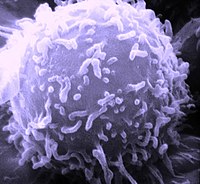
Photo from wikipedia
Insects protect themselves from microbial infections through innate immune responses, including pathogen recognition, phagocytosis, the activation of proteolytic cascades, and the synthesis of antimicrobial peptides. Termites, eusocial insects inhabiting microbe-rich… Click to show full abstract
Insects protect themselves from microbial infections through innate immune responses, including pathogen recognition, phagocytosis, the activation of proteolytic cascades, and the synthesis of antimicrobial peptides. Termites, eusocial insects inhabiting microbe-rich wood, live in closely-related family groups that are susceptible to shared pathogen infections. To resist pathogenic infection, termite families have evolved diverse immune adaptations at both individual and societal levels, and a strategy of trade-offs between reproduction and immunity has been suggested. Although termite immune-inducible genes have been identified, few studies have investigated the differential expression of these genes between reproductive and neuter castes, and between sexes in each caste. In this study, we compared the expression levels of immune-related genes among castes, sexes, and ages in a Japanese subterranean termite, Reticulitermes speratus. Using RNA-seq, we found 197 immune-related genes, including 40 pattern recognition proteins, 97 signalling proteins, 60 effectors. Among these genes, 174 showed differential expression among castes. Comparing expression levels between males and females in each caste, we found sexually dimorphic expression of immune-related genes not only in reproductive castes, but also in neuter castes. Moreover, we identified age-related differential expression of 162 genes in male and/or female reproductives. In addition, although R. speratus is known to use the antibacterial peptide C-type lysozyme as an egg recognition pheromone, we determined that R. speratus has not only C-type, but also P-type and I-type lysozymes, as well as other termite species. Our transcriptomic analyses revealed immune response plasticity among all castes, and sex-biased expression of immune genes even in neuter castes, suggesting a sexual division of labor in the immune system of R. speratus. This study heightens the understanding of the evolution of antimicrobial strategies in eusocial insects, and of sexual roles in insect societies as a whole.
Journal Title: PLoS ONE
Year Published: 2017
Link to full text (if available)
Share on Social Media: Sign Up to like & get
recommendations!